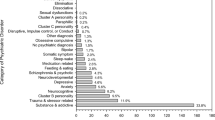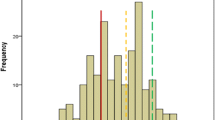Abstract
The purpose of this study was to explore the prevalence rates of co-occurring mental health problems among 70 flight attendants in substance abuse treatment. Results indicated that flight attendants in treatment were more likely to experience alcohol dependency than drug dependency. A high proportion of participants reported clinical levels of anxiety, major depressive disorder, dysthymia, and dependent personality disorder. Quality of life indicators suggested that the flight attendants were slightly above average in life satisfaction for a treatment population. Implications for clinical practice with this population were also discussed.
Similar content being viewed by others
References
Amaro, H., & Hardy-Fanta, C. (1995). Gender relations in addiction and recovery. Journal of Psychoactive Drugs, 27, 325–337.
American Psychiatric Association. (2000). Diagnostic and statistical manual of mental disorders (4th ed.). Arlington: Author. Text Revised.
Back, S., Dansky, B. S., Coffey, S. F., Saladin, M. E., Sonne, S., & Brady, K. T. (2000). Cocaine dependence with and without posttraumatic stress disorder: a comparison of substance use, trauma history and psychiatric comorbidity. The American Journal on Addictions, 9, 51–62. doi:10.1080/10550490050172227.
Blum, L. N., Nielsen, N. H., & Riggs, J. A. (1998). Alcoholism and alcohol abuse among women: report of the Council on Scientific Affairs, American Medical Association. Journal of Women's Health, 7, 861–871.
Blume, S. B. (1997). Women and alcohol: issues in social policy. In R. W. Wilsnack & S. C. Wilsnack (Eds.), Gender and alcohol: Individual and social perspectives (pp. 462–489). New Brunswick: Rutgers Center for Alcohol Studies.
Bonin, M. F., Norton, G. R., Asmundson, G. J., Dicurzio, S., & Pidlubney, S. (2000). Drinking away the hurt: the nature and prevalence of PTSD in substance abuse patients attending a community-based treatment program. Journal of Behavior Therapy and Experimental Psychiatry, 31, 55–66. doi:10.1016/S0005-7916(00)00008-2.
Bourland, S. L., Stanley, M. A., Snyder, A. G., Novy, D. M., Beck, J. G., Averill, P. M., et al. (2000). Quality of life in older adults with generalized anxiety disorder. Aging & Mental Health, 4, 315–323.
Calsyn, D. A., Wells, E. A., Fleming, C., & Saxon, A. J. (2000). Changes in Millon Clinical Multiaxial Inventory scores among opiate addicts as a function of retention in methadone maintenance treatment and recent drug use. The American Journal of Drug and Alcohol Abuse, 26(2), 297–309. doi:10.1081/ADA-100100606.
Copeland, J. (1997). A qualitative study of barriers to formal treatment among women who self-managed change in addictive behaviours. Journal of Substance Abuse Treatment, 14, 183–190. doi:10.1016/S0740-5472(96)00108-0.
Corey, K., Galvin, D., Cohen, M., Bekelman, A., Healy, H., & Edberg, M. (2005). Impact of the September 11 attack on flight attendants: a study of an essential first responder group. International Journal of Emergency Mental Health, 7(3), 227–240.
Craig, R. J., & Olson, R. E. (1998). Stability of the MCMI-III in a substance-abusing inpatient sample. Psychological Reports, 83(3), 1273–1274. doi:10.2466/PR0.83.7.1273-1274.
Craig, R. J., & Olson, R. E. (2001). Adjective descriptions of personality disorders: a convergent validity study of the MCMI-III. Journal of Personality Assessment, 77(2), 259–271. doi:10.1207/S15327752JPA7702_09.
Dansky, B. S., Saladin, M. E., Brady, K. T., Kilpatrick, D. G., & Resnick, H. S. (1995). Prevalence of victimization and posttraumatic stress disorder, and substance use and abuse among women with substance use disorders: comparison of telephone and in-person assessment samples. The International Journal of the Addictions, 30(9), 1079–1099.
Fabricius, V., Langa, M., & Wilson, K. (2008). An exploratory investigation of co-occurring substance-related and psychiatric disorders. Journal of Substance Abuse, 13(2), 99–114.
Flynn, P. M., & Brown, B. S. (2008). Co-occurring disorders in substance abuse treatment: issues and prospects. Journal of Substance Abuse Treatment, 34, 36–47. doi:10.1016/j.jsat.2006.11.013.
Frisch, M. (1994). Quality of life inventory: manual and treatment guide. Minneapolis: National Computer Systems.
Frisch, M. B., Cornell, J., Villaneuva, M., & Retzlaff, P. J. (1992). Clinical validation of the Quality of Life Inventory: a measure of life satisfaction in treatment planning and outcome assessment. Psychological Assessment, 4, 92–101. doi:10.1037/1040-3590.4.1.92.
Frisch, M. B., Clark, M. P., Rouse, S. V., Rudd, M. D., Paweleck, J. K., Greenstone, A., et al. (2005). Predictive and treatment validity of life satisfaction and the Quality of Life Inventory. Assessment, 12(1), 66–78. doi:10.1177/1073191104268006.
Gibertini, M., Branderberg, N., & Retzlaff, P. (1986). The operating characteristics of the Millon Clinical Multiaxial Inventory. Journal of Personality Assessment, 50, 554–567. doi:10.1207/s15327752jpa5004_3.
Goodwin, D. W., & Gabrielli, W. F. (1997). Alcohol: clinical aspects. In J. H. Lowinson, P. Ruiz, R. B. Millman, & J. G. Langrod (Eds.), Substance abuse: A comprehensive textbook (3rd ed., pp. 142–148). Baltimore: Williams & Wilkins.
Grant, G. M., Salcedo, V., Hynan, L. S., Frisch, M. B., & Puster, K. (1995). Effectiveness of quality of life therapy for depression. Psychological Reports, 76, 1203–1208.
Grant, B. F., Stinson, F. S., Dawson, D. A., Chou, S. P., Dufour, M. C., Compton, W., et al. (2006a). Prevalence and co-occurrence of substance use disorders and independent mood and anxiety disorders: results from the National Epidemiologic Survey on alcohol and related conditions. Alcohol Research & Health, 29(2), 107–120.
Grant, B. F., Stinson, F. S., Dawson, D. A., Chou, S. P., Dufour, M. C., Ruan, W. J., et al. (2006b). Co-occurrence of 12-month alcohol and drug use disorders and personality disorders in the United States. Alcohol Research & Health, 29(2), 121–130.
Greenfield, S. F., Brooks, A. J., Gordon, S. M., Green, C. A., Kropp, F., McHugh, R. K., et al. (2007). Substance abuse treatment entry, retention, and outcome in women: A review of the literature. Drug and Alcohol Dependence, 86, 1–21. doi:10.1016/j.drugalcdep.2006.05.012.
Grella, C. E., Joshi, V., & Hser, Y. I. (2000). Program variation in treatment outcomes among women in residential drug treatment. Evaluation Review, 24, 364–383.
Kessler, R. C., Chiu, W. T., Demler, O., & Walters, E. E. (2005). Prevalence, severity, and comorbidity of 12-month DSM-IV disorders in the National Comorbidity Survey Replication. Archives of General Psychiatry, 62, 617–627. doi:10.1001/archpsyc.62.6.617.
Klein, D. N., & Shih, J. H. (1998). Depressive personality: associations with DSM-III-R mood and personality disorders, and negative and positive affectivity 30-month stability, and prediction of course of axis 1 depressive disorders. Journal of Abnormal Psychology, 107, 319–327. doi:10.1037/0021-843X.107.2.319.
Lating, J. M., Sherman, M. F., Everly, G. S., Jr., Lowry, J. L., & Peragine, T. F. (2004a). PTSD reactions and functioning of American Airlines flight attendants in the wake of September 11. The Journal of Nervous and Mental Disease, 192(June, 6), 435–441.
Lating, J. M., Sherman, M. F., Everly, G. S., Jr., Lowry, J. L., & Peragine, T. F. (2004b). PTSD reactions and coping responses of East Coast and West Coast American Airlines flight attendants after September 11: a possible psychological contagion effect? The Journal of Nervous and Mental Disease, 192(December, 12), 876–879.
Lating, J. M., Sherman, M. F., & Peragine, T. F. (2006). PTSD reactions and coping responses of American Airlines flight attendants who were former employees of Trans World Airlines: further support of a psychological contagion effect. Brief Treat Crisis Interv, 6(2), 144–153. doi:10.1093/brief-treatment/mhj016.
McAlinden, N. M., & Oei, T. P. S. (2006). Validation of the Quality of Life Inventory for patients with anxiety and depression. Comprehensive Psychiatry, 47(4), 307–314. doi:10.1016/j.comppsych.2005.09.003.
McCollum, E. E., & Trepper, T. S. (1995). "Little by little, pulling me through" – women's perceptions of successful drug treatment: a qualitative inquiry. J Fam Psychother, 6, 63–82. doi:10.1300/j085V06N01_06.
Substance Abuse and Mental Health Services Administration, Office of Applied Studies (SAMHSA). (2008). Treatment Episode Data Set (TEDS): 1996–2006. National Admissions to Substance Abuse Treatment Services. Author: Rockville. DASIS Series: S-43, DHHS Publication No. (SMA) 08–4347.
Millon, T. (1997). Millon Clinical Multiaxial Inventory-III manual (2nd ed.). Minneapolis, MN: National Computer System.
Orstavik, R. E., Kendler, K. S., Czajkowski, N., Tambs, K., & Reichborn-Kjennerud, T. (2007). The relationship between depressive personality disorder and major depressive disorder: a population-based twin study. The American Journal of Psychiatry, 164, 1866–1872. doi:10.1176/appi.ajp.2007.07010045.
Ouimette, P. C., Gima, K., Moos, R. H., & Finney, J. W. (1999). A comparative evaluation of substance abuse treatment IV. The effect of comorbid psychiatric diagnosis on amount of treatment, continuing care, and 1-year outcomes. Alcoholism, Clinical and Experimental Research, 23(3), 552–557.
Retzlaff, P. D. (1998). Review of the Millon Clinical Multiaxial Inventory-III. In J. C. Impara & B. S. Plake (Eds.), Thirteenth mental measurements yearbook (pp. 667–668). Lincoln NE: Buros Institute.
Siegfried, N. (1998). A review of comorbidity: major mental illness and problematic substance abuse. Aust N Z J Psychiatry, 32(5), 707–717. doi:10.3109/00048679809113127.
Skodol, A. E., Gallaher, P. E., & Oldham, J. M. (1996). Excessive dependency and depression: is the relationship specific? The Journal of Nervous and Mental Disease, 184(3), 165–171. doi:10.1097/00005053-199603000-00005.
Teplin, D., O’Connell, T., Daiter, J., & Varenbut, M. (2004). A psychometric study of the prevalence of DSM-IV personality disorders among office-based methadone maintenance patients. The American Journal of Drug and Alcohol Abuse, 30(3), 515–524. doi:10.1081/ADA-200032270.
Tuten, M., & Jones, H. E. (2003). A partner's drug-using status impacts women's drug treatment outcome. Drug and Alcohol Dependence, 70, 327–330. doi:10.1016/S0376-8716(03)00030-9.
Author information
Authors and Affiliations
Corresponding author
Rights and permissions
About this article
Cite this article
Horton, G., Diaz, N., Mcilveen, J. et al. Mental Health and Substance Use Characteristics of Flight Attendants Enrolled in an In-Patient Substance Abuse Treatment Program. Int J Ment Health Addiction 9, 140–150 (2011). https://doi.org/10.1007/s11469-011-9316-7
Published:
Issue Date:
DOI: https://doi.org/10.1007/s11469-011-9316-7




